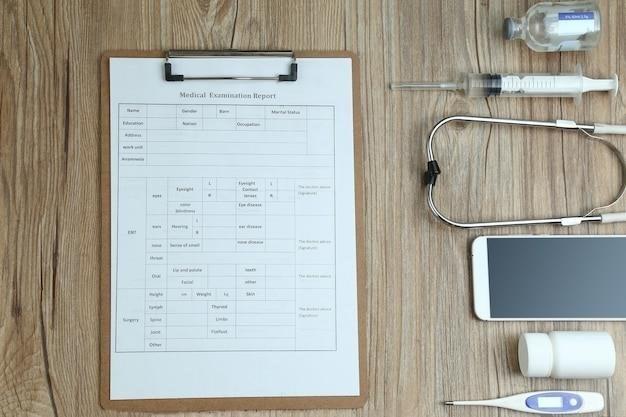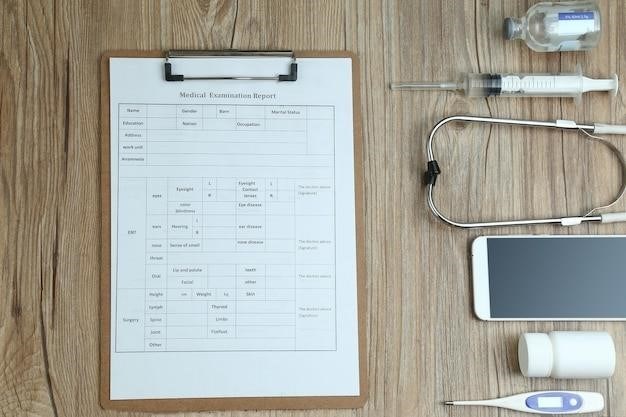
iosh risk assessment form filled pdf
Understanding the IOSH Risk Assessment Form
The IOSH risk assessment form is a crucial document for identifying and mitigating workplace hazards․ It’s a structured approach to systematically evaluate risks, ensuring a safe working environment․ Proper completion is vital for compliance and preventing incidents․
What is an IOSH Risk Assessment?
Key Components of the IOSH Form
A typical IOSH risk assessment form includes sections for identifying hazards, assessing risks, and detailing control measures․ The hazard identification section requires a detailed description of potential dangers present in the workplace․ This is followed by an assessment of the likelihood and severity of harm, often using a matrix to categorize risks based on these factors․ Crucially, the form necessitates outlining existing control measures already in place to mitigate identified hazards․ Further, it prompts the development of additional control measures to reduce risks to an acceptable level․ The form also typically requires a clear assignment of responsibilities for implementing and monitoring these controls․ Finally, a review date is essential to ensure ongoing effectiveness․ This allows for reassessment of the identified hazards and the efficacy of implemented control measures, reflecting the dynamic nature of workplace safety․ The form’s structure ensures comprehensive documentation, facilitating compliance and providing a valuable record for future reference and audits․
Identifying Hazards and Assessing Risks
The process begins with a systematic identification of potential hazards within the workplace․ This involves a thorough examination of the work environment, tasks performed, and the equipment used․ Consider all potential sources of harm, including physical hazards like slips, trips, and falls; chemical hazards from exposure to substances; biological hazards from bacteria or viruses; ergonomic hazards from repetitive movements; and psychosocial hazards stemming from stress or workload․ Once hazards are identified, the next step is risk assessment․ This involves evaluating the likelihood of harm occurring and the severity of the potential consequences․ A common approach is to use a risk matrix that combines likelihood and severity scores to determine an overall risk rating․ This rating helps prioritize the risks, focusing resources on the most significant threats first․ The use of clear and concise language is crucial throughout this process to ensure everyone involved understands the identified hazards and the associated risks․ This clarity is critical for effective communication and implementation of preventative measures․

Completing the IOSH Risk Assessment Form
Accurate completion of the IOSH risk assessment form is paramount․ Follow the step-by-step instructions carefully, ensuring all sections are filled out completely and correctly․ This will help ensure a thorough and effective risk assessment․
Step-by-Step Guide to Filling the Form
Begin by clearly identifying the task or activity being assessed․ List all potential hazards associated with that task, considering both obvious and less apparent risks․ For each hazard, identify who might be harmed and how․ Then, evaluate the likelihood and severity of harm using a risk matrix or similar system provided within the IOSH guidance or your organization’s specific procedures․ This often involves assigning risk ratings based on the combination of likelihood and severity․ Based on your risk assessment, determine the necessary control measures to mitigate the identified hazards․ These measures might include engineering controls (e․g․, guarding machinery), administrative controls (e․g․, implementing safe work procedures), or personal protective equipment (PPE)․ Remember to document the control measures clearly within the form, specifying who is responsible for their implementation and the timeframe for completion․ Finally, establish a review date for the risk assessment to ensure its ongoing effectiveness and to account for any changes in the work environment or processes․ Remember to sign and date the completed form, indicating the assessor’s name and any relevant organizational details․ Adherence to this systematic approach ensures a comprehensive and legally compliant risk assessment․
Examples of Completed Forms
While specific examples of completed IOSH risk assessment forms aren’t readily available online due to confidentiality concerns surrounding real-world workplace data, understanding their structure is key․ A well-completed form will clearly show the systematic process of hazard identification, risk evaluation, and control measure implementation․ Imagine a form assessing work at heights․ The hazard might be a fall from a scaffold․ The risk rating would be high due to the potential for severe injury or fatality․ Control measures might include using appropriate fall protection equipment, such as harnesses and safety nets, along with regular inspections of the scaffold’s stability․ Another example could involve manual handling․ Hazards might include back strain or injury․ Control measures could involve using lifting aids, training staff on proper lifting techniques, and ensuring that loads are manageable․ A completed form should clearly show the steps taken to reduce these risks and improve safety․ Reviewing these examples, even hypothetical ones, is crucial in comprehending how to effectively populate a form and meet the requirements of a valid and thorough risk assessment․ The overall goal is to demonstrate a clear understanding of risk assessment principles․
Common Mistakes to Avoid
A frequent error is failing to identify all potential hazards․ Thoroughness is paramount; overlooking even minor risks can have significant consequences․ Another common mistake involves vague or insufficient descriptions of hazards․ Clear, concise language is vital for accurate risk assessment․ Using ambiguous terms like “ongoing” for review dates is unacceptable; specific timelines are needed․ Incorrect risk ratings are also prevalent․ Understanding the IOSH Action Level Table is crucial for accurately assessing risk levels․ Insufficient control measures represent another pitfall․ Proposed measures must be effective, practical, and feasible for the specific workplace․ Finally, neglecting to document the review date is a critical error․ Regular reviews are essential to ensure ongoing effectiveness of control measures․ These mistakes can lead to inadequate risk management, jeopardizing worker safety and potentially resulting in non-compliance with health and safety regulations․ Careful attention to detail and adherence to best practices are essential to avoid these common pitfalls․

Reviewing and Submitting the Form
After completing the IOSH risk assessment form, a thorough review is essential before submission․ Ensure accuracy, completeness, and adherence to IOSH guidelines․ Timely submission is also crucial․
The Importance of Review Dates
Regular review dates are paramount in maintaining the effectiveness and relevance of your IOSH risk assessment․ These dates aren’t arbitrary; they signify a commitment to ongoing safety and proactive hazard management․ Specifying review dates ensures that the assessment remains a dynamic document, adapting to changes in the workplace, processes, and regulatory standards․ Failing to schedule reviews can lead to outdated information, rendering your assessment ineffective․ Regular reviews allow for the evaluation of existing control measures and their efficacy in mitigating identified risks․ Have identified hazards been adequately addressed? Are control measures still appropriate and functioning correctly? These are crucial questions that periodic reviews help answer, ensuring that the safety measures put in place remain relevant and effective in protecting workers․ The frequency of these reviews will depend on the nature and level of risk identified; high-risk environments will obviously demand more frequent assessments than lower-risk ones․ By establishing a schedule of review dates, you demonstrate a commitment to continuous improvement in workplace safety, minimizing potential risks and fostering a safer work environment for everyone․
Finalizing and Submitting Your Assessment
Before submitting your completed IOSH risk assessment form, meticulously review every section for accuracy and completeness; Ensure all identified hazards are clearly listed, along with the associated risks and implemented control measures․ Verify that the risk rating for each hazard aligns with the IOSH Action Level Table, ensuring consistency and adherence to established guidelines․ Double-check that the assigned review dates are realistic and appropriate, allowing for timely reassessment and updates․ Confirm that all necessary signatures and details, including those of the assessor and training provider (if applicable), are accurately recorded․ Once you are fully satisfied with the accuracy and thoroughness of the completed form, proceed with the submission process according to your organization’s established procedures․ This may involve electronic submission through a designated portal or physical submission to a designated individual or department․ Maintain a copy of the submitted assessment for your records․ Remember, a well-executed and properly submitted IOSH risk assessment demonstrates a commitment to workplace safety and legal compliance․ Following these steps ensures a professional and effective completion of this critical document․
Passing the IOSH Managing Safely Risk Assessment
Success in the IOSH Managing Safely Risk Assessment hinges on a comprehensive understanding of risk assessment principles and their practical application․ The assessment evaluates your ability to identify hazards, analyze risks, and develop effective control measures․ Thorough preparation is key; familiarizing yourself with the IOSH guidance and utilizing practice examples can significantly improve your performance․ Accuracy in identifying real hazards is crucial; avoid including fictitious or irrelevant risks․ The assessment also tests your ability to use the IOSH Action Level Table to correctly determine risk ratings and prioritize control measures․ Your project submission must demonstrate a clear understanding of the process, from hazard identification to risk control implementation, and must be well-organized and easy to follow․ Remember, the pass mark may vary depending on the specific course and assessment criteria set by IOSH and your training provider․ However, generally, a combined score of 60% or higher across the project and exam is required for certification․ While there’s no single “magic formula,” diligent study, practice, and a clear understanding of the assessment criteria will significantly enhance your chances of success․